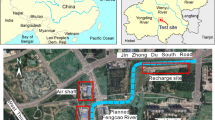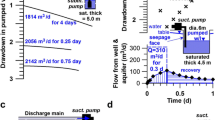Abstract
Field observation and numerical simulations were carried out to evaluate the hydraulic relationship between the shallow and deep aquifer of a High Plains Aquifer system, in which shallow and deep aquifers are separated by an aquitard. Pumping from the lower aquifer resulted in a small drawdown in the upper aquifer and a larger drawdown in the aquitard; pumping from the shallow aquifer caused a small drawdown in the aquitard and the deep aquifer. Analysis of pumping test data gives the values of the hydraulic conductivity of the aquitard and the deep aquifer. Long-term observation of groundwater levels in the shallow and deep aquifers showed that a strong downward hydraulic gradient was maintained during an irrigation season. Numerical simulations were used to calculate the induced leakage of water from the shallow to the deep aquifer. Water budget analyses suggested that after pumping continues for a couple of days, the leakage from the overlying layers begins to supply the majority of the withdrawal from the deep aquifer. However, the induced leakage from the upper shallow aquifer can travel only a few meters into the aquitard, and it can not reach the lower aquifer during a 90 day pumping period. The major portion of the induced leakage occurred during the pumping period, but a small leakage can continue as a residual effect after the pumping period. The vertical hydraulic conductivity of the aquitard plays a major role in partitioning the ratio of the induced leakage for the pumping and after-pumping periods.








Similar content being viewed by others
References
Ayers JF, Chen XH, Gosselin D (1998) Behavior of nitrate-nitrogen movement around a pumping high-capacity well: a field example. Ground Water 36(2):325–337
Andreason GE, Brookhart JW (1963) Reverse water—level fluctuations. In: Bentall R (ed) Methods of collecting and interpreting ground-water data. US Geological Survey Water-Supply Paper 1544-H, pp 30–35
Butler JJ Jr, Tsou MS (2003) Pumping-induced leakage in a bounded aquifer: an example of a scale-invariant phenomenon. Water Resources Res 39(12):2-1–2-8
Chen XH, Goeke J, Ayers J, Summerside S (2003) Observation well network design for pumping tests in unconfined aquifers. J Am Water Resources Assoc 39(1):17–32
Druliner AD, Chen H H, McGrath TS (1996) Relations of nonpoint-source nitrate and atrazine. US Geological Survey Water-Resources Investigations Report 95-4202, 51p
Engberg RA, Spalding RF (1978) Groundwater Quality Atlas of Nebraska. University of Nebraska-Lincoln Conservation and Survey Division Resource Atlas No. 3, 39 p
Flowerday CA, Kuzelka RD, Pederson DP (Compilers) (1998) The Groundwater Atlas of Nebraska, 2nd edn. University of Nebraska-Lincoln conservation and Survey Division Resource Atlas No. 4a, 44p
Hantush MS, Jacob CE (1955) Non-steady radial flow in an infinite leaky aquifer. Trans Am Geophys Union 36:95–100
Hantush MS (1964) Hydraulics of wells. Advances in hydro-science. Academic, New York
Harbaugh AW (1990) A computer program for calculating subregional water budgets using results from the US Geological Survey modular three-dimensional ground-water flow model: US Geological Survey Open-File Report 90-392, 46 pp
Harbaugh AW, Banta ER, Hill MC, McDonald MG (2000) MODFLOW-2000, the US Geological Survey Modular Ground-Water Model: User guide to modularization concepts and the ground-water flow process. US Geological Survey Open-File Report 00-92, 121 pp
Hill MC, Banta ER, Harbaugh AW, Anderman ER (2000) MODFLOW-2000, the US Geological Survey Modular Ground-Water Model: User guide to the observation, sensitivity, and parameter-estimation processes and three post-processing programs. US Geological Survey Open-File Report 00-184, 209 pp
Hsieh PA (1996) Deformation-induced changes in hydraulic head during groundwater withdrawal. Ground Water 34(6):1082–1089
Jacquard P, Jain C (1965) Permeability distribution from field pressure data. Trans Soc Pet Eng 5(4):281–294
Jahns HO (1966) A rapid method for obtaining a two-dimensional reservoir description from well pressure response data. Trans Soc Pet Eng 237:315–327
Kim JM, Parizek RR (1997) Numerical simulation of the Noordbergun effect resulting from groundwater pumping in a layered aquifer system. J Hydrol 202(1–4):231–243
McGuire VL, Kilpatrick JM (1998) Hydrogeology in the vicinity of the Nebraska management systems evaluation area site, central Nebraska. US Geological Survey Water-Resources Investigations Report 97-4266
McGuire VL, Johnson MR, Schieffer RL, Stanton JS, Sebree SK, Verstraeten IM (2003) Water in storage and approaches to groundwater management, high plains aquifer, 2000. US Geological Survey Circular 1243, 51 pp
Neuman SP, Witherspoon PA (1969) Applicability of current theories of flow in leaky aquifers. Water Resources Res (5):817–829
Pollock DW (1989) Documentation of computer programs to compute and display pathlines using results from the US Geological Survey modular three-dimensional finite-difference ground-water flow model, US Geological Survey Open-File Report 89-381
Rodrigues JD (1983) The Noordbergum effect and characterization of aquitards at the Rio Maior mining project. Ground Water 21(2):200–207
Spalding RF, Watts DG, Schopors JS, Burbach ME, Exner ME, Poreda RJ, Martin GE (2001) Controlling nitrate teaching in irrigated agriculture. J Environ Quality 30(4):1184--1194
U.S. Geological Survey (2002) The High Plains Aquifer, http://www-ne.cr.usgs.gov/highplains/hpchar.html, accessed on January 12, 2003
Yeh WW (1986) Review of parameter identification procedures in groundwater hydrology: the inverse problem. Water Resources Res 22(2):95–108
Zlotnik VA, Zurbuchen BR (1998) Dipole probe: design and field applications of a single-borehole device for measurements of vertical variations of hydraulic conductivity. Ground Water 36(6):884–893
Acknowledgments
The research was supported by the US Geological Survey, Conservation and Survey Division, and the Water Center of the University of Nebraska-Lincoln. C. Flowerday edited the manuscript. D. Gosselin and J. Szilagyi reviewed the manuscript. Dee Ebbeka and Ann Mack drafted several figures. This paper is assigned as Journal Series No. 14269, Agricultural Research Division, University of Nebraska-Lincoln
Author information
Authors and Affiliations
Corresponding author
Rights and permissions
About this article
Cite this article
Chen, X., Yin, Y., Goeke, J.W. et al. Vertical movement of water in a High Plains Aquifer induced by a pumping well. Environ Geol 47, 931–941 (2005). https://doi.org/10.1007/s00254-005-1223-4
Received:
Accepted:
Published:
Issue Date:
DOI: https://doi.org/10.1007/s00254-005-1223-4




